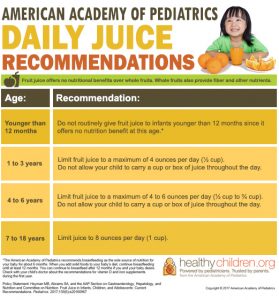
Historically, fruit juice was recommended by pediatricians as a source of vitamin C and as an extra source of water for healthy infants and young children as their diets expanded to include solid foods with higher renal solute load. It was also sometimes recommended for children with constipation. Fruit juice is marketed as a healthy, natural source of vitamins and, in some instances, calcium. Because juice tastes good, children readily accept it. Although juice consumption has some benefits, it also has potential detrimental effects. High sugar content in juice contributes to increased calorie consumption and the risk of dental caries. In addition, the lack of protein and fiber in juice can predispose to inappropriate weight gain (too much or too little). Pediatricians need to be knowledgeable about juice to inform parents and patients on its appropriate uses.
Between 2008 and 2013, sales of juice and juice drinks have declined, likely as a result of competing beverages and increasing consumption of healthier food options, specifically fruit and vegetables. Drinks containing tropical fruit, teas, sports and energy drinks, and other combinations (“hybrids”) present an array of newer and more fashionable options. Children and adolescents continue to be the highest consumers of juice and juice drinks. Healthier beverage options are gaining popularity, including lower-calorie, unsweetened beverages, as well as those with perceived benefits from ingredients such as herbs and spices. Unfortunately, data revealed that children 2 to 18 years of age consume nearly half of their fruit intake as juice, which lacks dietary fiber and predisposes to excessive caloric intake. This proportion has decreased in recent years.